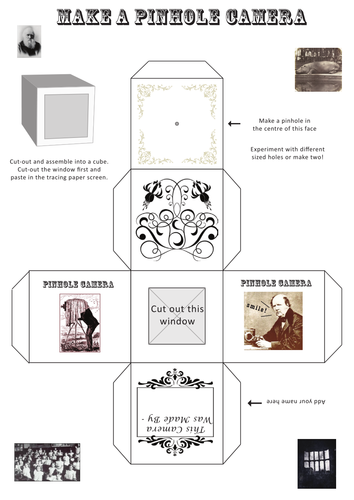An ordinary camera has a lens that makes an image on film. In a pinhole camera. A small hole replaces the lens. You can construct a pinhole camera using: • corrugated cardboard from a box, or stiff cardboard from the back of a pad of paper • black paper • black tape • a cartridge of 126 film* • aluminum foil • two large rubber bands • a ruler • a pencil • scissors • a sharp knife • a straight pin or sewing needle Making a pinhole camera The diagram shows the basic construction of a pinhole camera. The body of the camera is a cardboard box that is open at both ends. To make this box, cut a rectangle of cardboard that measures 5 3/4 inches by 2 inches. Divide the long edge of the rectangle into four equal sections.

Anyone who pledges to Angood's Kickstarter campaign will get a free PDF download of a smaller pinhole camera design, also by Angood, that can also be printed and recreated from cardboard The.
Lotus Smartsuite 9.8.6 Torrent. As of June 1. IBM Lotus Smart. Suite and Organizer are not available for download from the Passport Advantage website. Kindlatlas.jimdo.com Ibm Lotus Organizer 6.1 (7 Downloads) - FileFortune To create more accurate search results for Ibm Lotus Organizer 6.1 try to exclude using. Lotus Smartsuite Millennium 9.8 5 torrent download locations monova.org Lotus Smartsuite Millennium 9.8 Software 2 days torrentdownloads.me Lotus Smartsuite Millennium 9 8 Windows - Other 2 days torrentfunk2.com Lotus Smartsuite Millennium 9 8 Software 2 months bittorrent.am Lotus Smartsuite Millennium 9.8 Apps 1 day btdb.to Lotus Smartsuite. Lotus smartsuite 97. Lotus Smartsuite 9.8.6 Torrent. In July 2012 the price for a user licence of Lotus SmartSuite 9.8 was US-$342.00 when purchased directly through the IBM website. Torrent Contents. Lotus SmartSuite 9.8.iso 696 MB; Please note that this page does not hosts or makes available any of the listed filenames. You cannot download any. Lotus SmartSuite 9.8This was the last one released by IBM-LotusIt is discontinued software. Skip to main content Search the history of over 349 billion web pages on the Internet.
Use your knife to score the cardboard along each of the lines. Fold the cardboard along the scores to make an open-ended box. Before you tape the edges together to make a box, you need to make the interior black to minimize reflection of light within the camera. You can cut a piece of black paper and fold it to make a black lining for your box, or you can cover the inside surface of the cardboard with strips of black tape. You could also paint the inside flat black with spray paint or tempera. Now tape the edges together to make a box, and tape all the box's edges and corners to prevent light from leaking into the camera.
Insert the box into the film cartridge as shown. It should fit tightly.
When you hold the open end of the box up to your eye, you shouldn't see any light leaking in where the box fits into the cartridge. To make the front of the camera, cut a rectangle of cardboard that measures about 1 3/4 by 3 inches. Cut a square hole that measures about 1/2 inch by 1/2 inch in the center of the rectangle. Line the inside of the front of the box with black paper or tape, leaving the hole open.
Tape a 1-inch square of aluminum foil over the square hole, and make a small pinhole in the center of the foil. When you aren't taking a picture, you need to cover the pinhole with black paper. We made a shutter that slides into black paper guides. To ensure that no light can leak in, tape the box to the front with black tape. Fasten the camera to the cartridge with rubber bands, as shown.
Taking photos with your pinhole camera Through the window in the back of the film cartridge, you'll see arrows. Use a coin as shown in the diagram, turning it clockwise to advance the film in the direction of the arrows. Eventually, you'll see the frame number 1 through the window, the first in a series of 1's. Stop advancing the film when the third and fourth 1 in the series are both visible through the window.
Now you're ready to take a picture. To get a sharp photo, it's important to hold your pinhole camera steady To keep the camera steady.
One of our staff suggested that you 'tape it to a brick.' He attached his pinhole camera to a tripod with rubber bands. This photo was taken with a pinhole camera. Using ASA 200 film in bright sunlight, we found that we got good pictures with exposure times varving from one to three seconds. The ideal exposure time will depend on the size of your pinhole and the brightness of the day. Experiment with different exposure times, and you'll learn which times give the best results. After each photo.